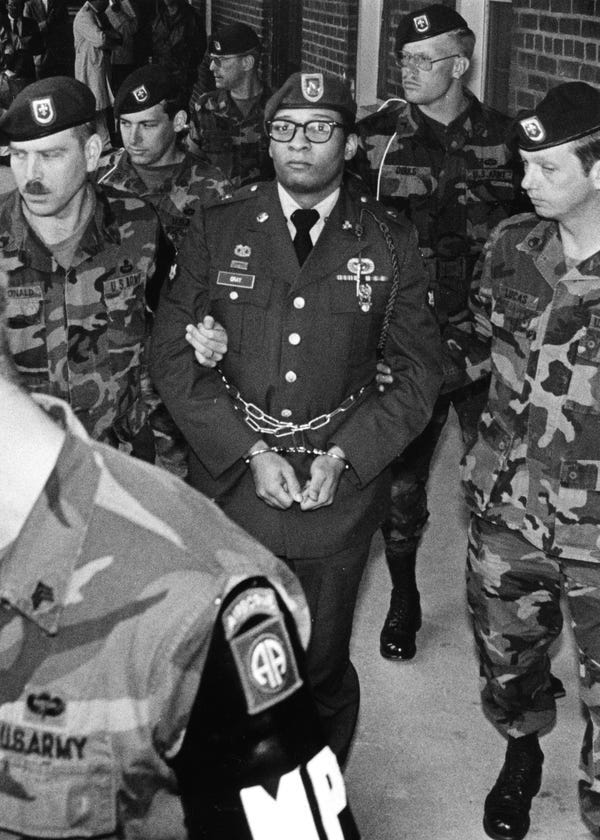The Fort Bragg Predator: The Grisly Crimes of US Army Serviceman Ronald Gray
During 1986 and 1987, several women were assaulted and murdered on or near Fort Bragg, North Carolina. Disturbingly, DNA evidence would reveal that the perpetrator was a soldier stationed there
Background
As a soldier in the United States Army stationed at Fort Bragg, North Carolina, Ronald Gray lived a double life, committing horrific crimes that shocked the military and the general public.
Prior to that, Gray was viewed as an average serviceman. However, beneath his seemingly normal facade lay a calculating and dangerous predator.
Gray’s crimes—a spree of rapes, murders, and attempted murders between 1986 and 1987—exposed the darkness lurking within his seemingly disciplined life.
Early Life and Military Career
Ronald Adrin Gray was born on August 14, 1965, in Cochran, Georgia, but was raised in the Liberty Square housing projects in Miami, Florida. To escape the bleak living conditions, Gray enlisted in the U.S. Army, seeking discipline and a stable career path.
He was posted at Fort Bragg, where he worked alongside fellow soldiers. He was known to be a hardworking yet unremarkable soldier.
Despite this outward normalcy, early warning signs of Gray’s predatory behavior began to emerge. Reports from acquaintances suggest a pattern of manipulation and a lack of empathy.
However, these traits were largely overlooked or dismissed, allowing Gray to operate undetected for an extended period.
Double Life
Between 1986 and 1987, Ronald Gray committed a series of escalating violent crimes, targeting vulnerable women near Fort Bragg. His modus operandi involved luring women into isolated areas, often under the guise of friendliness or authority, before attacking them.
On April 27, 1986, Private Mary Ann Lang Nameth was raped and murdered, and her body was found burned beyond recognition. Nameth, who had been exercising near her barracks at Fort Bragg, was found in a wooded area.
Later, DNA and fingerprints left at the scene of the crime linked Gray to the murder. Nameth’s murder sent shockwaves through the military community, raising concerns about safety on and around Fort Bragg.
On April 28, 1986, just one day after murdering Private Mary Ann Lang Nameth, Gray attacked another woman. This victim survived the assault and provided key testimony that would later aid investigators.
Her description of Gray’s appearance and the details of the attack would become critical in piecing together the timeline of his crimes.
Another chilling incident involved Kimberly Ann Ruggles, a 23-year-old cab driver. On December 15, 1986, Ruggles was dispatched for a routine pickup but never returned. Her body was discovered later that evening in a secluded area, showing signs of sexual assault and strangulation.
The brutality of her murder and its occurrence so close to Fort Bragg heightened public fear and scrutiny of the military’s ability to police its own personnel.
Gray’s violence continued unabated, with multiple cases of rape, attempted murder, and murder occurring over the next year. He displayed calculated cruelty, leaving little evidence beyond forensic traces.
However, advances in DNA testing and the accounts of surviving victims began to build a damning case against him.
Arrest
Ronald Gray’s eventual capture resulted from tireless efforts by military and civilian law enforcement agencies. Investigators conclusively linked him to the crimes through DNA evidence, survivor testimonies, and circumstantial connections. The coordinated efforts culminated in his arrest at Fort Bragg on January 6, 1987.
His arrest marked a turning point in the case, as investigators uncovered evidence tying him to multiple crimes. The public reaction was one of disbelief and outrage. The idea that a trusted soldier could commit such heinous acts tainted the image of the military as a sanctuary of honor and discipline.
Trial and Sentence
In 1988, Ronald Gray faced court-martial under the Uniform Code of Military Justice. The evidence against him was overwhelming. He was convicted of four counts of murder, one count of attempted murder, and eight counts of rape.
The military tribunal sentenced him to death, a rare outcome in military justice.
Gray’s appeals over the decades have failed to overturn his sentence. He remains on death row at the United States Disciplinary Barracks in Fort Leavenworth, Kansas, one of the few individuals in the U.S. military still facing capital punishment.
Closing Thoughts
The case of Ronald Gray is a chilling reminder of the capacity for violence hidden beneath the surface of seemingly ordinary lives. His crimes not only devastated the lives of his victims and their families but also eroded trust within the military community.
Gray’s dual existence as a soldier and a serial predator reveals the disturbing reality of how a predator can operate unnoticed within a trusted institution.
Sources:
Department of Defense. (1988). Court-martial records of Ronald Adrin Gray. Washington, D.C.: United States Army.
CNN. (2008). Army death row inmate loses appeal. Retrieved from https://www.cnn.com
Brown, J. R. (2001). Military justice and capital punishment: The case of Ronald Gray. Military Law Review, 169(2), 15-48.
North Carolina Department of Public Safety. (2001). Profiles of convicted serial offenders in North Carolina. Raleigh, NC: NCDPS.
United States v. Gray, 51 M.J. 1 (C.A.A.F. 1999). Retrieved from https://www.army.mil











